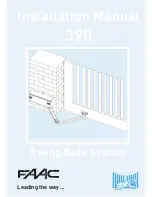
115 Vac (±5%) 50/60 Hz
330W 400W
3 A 3,5 A
1550 rpm
1/30
-20°C +55°C
130°C
15 Kg
1,75 L.
IP44
10,5 m/min
12 m/min
800 Kg 1800 Kg
800
1800
2000 Kg
800 Kg
400 Kg
300 Kg
L
E
P
U
S
8
0
0
C
O
N
T
IN
U
O
1800 Kg
25%
75%
100%
40%
60%
L
E
P
U
S
8
0
0
C
O
N
T
IN
U
O
L
E
P
U
S
1
8
0
0
L
E
P
U
S
8
0
0
L
E
P
U
S
8
0
0
L
E
P
U
S
1
8
0
0
Sistemi elettronici
di Aperture Porte e Cancelli
INSTRUCCIONES DE MONTAJE Y CONEXIÓN
LEPUS
es un
motorreductor completamente a baño de
aceite
proyectado para automatizar cancelas corredizas. La
irreversibilidad
del motorreductor permite un cierre perfecto y
seguro de la cancela evitando la instalación de una
electrocerradura y en caso de falta de alimentación el
dispositivo de desbloqueo puesto en la parte delantera del
motorreductor permite la abertura y el cierre manual. El
oberador está provisto de un
embrague mecánico ajustable
,
el cual garantiza una regulación del empuje de la cancela.
Además,
el dispositivo electrónico de inversión
realizado
por medio del
encoder
vuelve motorreductor lepus un oberador
seguro y fiabile permitendo de manera simple el cumplimiento
de las normativas vigentes en los países donde este producto
viene istalado.
1
Placa de fundación ajustable
2
Pernos de anclaje
3
Angulares de fijación
4
Cubreangular
5
Piñón
DATOS TÉCNICOS
Tensión de alimentación
Potencia
Corriente absorbida
Velocidad de rotación del motor
Relación de riducción
Temperatura ambiente
Intervención de la termoproteción
Peso actuador con aceite
Cantidad de aceite
Grado de protección
Velocidad (piñón Z16)
Velocidad (piñón Z20)
Peso Max cancela
Embrague mecánico
Tope inductivo o mecánico
10
10
7
7
8
8
9
9
1
1
2
2
3
3
4
4
5
5
6
6
F
re
c
u
e
n
c
ia
d
e
u
s
o
P
e
s
o
m
a
x
c
a
n
c
e
la
Motorreductor a bano de aceite
6
Palanca desboqueo reductor
7
Tornillo regulación embrague mecánico
8
Equipo electrónico
9
Tapón relleno do aceite
10
Encoder magnético
NOMENCLATURA PARTES PRINCIPALES
ESPAÑOL
GRÁFICO DE UTIZACIÓN MOTORREDUCTOR LEPUS
3
7
.5
4
325
16
0
1. PREDISPOSICIÓN DE LA CANCELA
En primer lugar controlar que todas las partes de la cancela (fijas
y moviles) tengan una estructura resistente y lo más posible
indeformable, y cuanto sigue:
a) que la hoja sea suficientemente rigida y compacta;
b) que la guía de deslizamiento inferior sea perfectamente
rectilinea, horizontal y privada de irregularidades que puedan
obstaculizar el deslizamiento de la cancela;
c) que las ruedas de deslizamiento inferior sean provistas de
cojinetes de bolas lubrificadas o de capacidad estanca;
d) que la guía superior esté realizada y posicionada de modo
que la cancela resulte perfectamente vertical;
e) que sean siempre instalados los paros de fines de carrera de
la hoja para evitar descarrillamientos de la misma.
DIMENSIONES (mm)
REV 04 - 09/2005
cod. 67410012
LEPUS






























